Leveraging sensitivity for quantification of insulin degludec on a high-end triple quadrupole mass spectrometer with minimal sample preparation
Increasing sensitivity for quantification of insulin analogs using the SCIEX 7500 system, powered by SCIEX OS software
Junmiao Chen1 , Dandan Si1 , Zhimin Long1 and Ebru Selen2
1SCIEX, China; 2SCIEX, USA
Abstract
This technical note demonstrates a highly sensitive quantification workflow for insulin analogs in rat plasma on a high-end triple quadrupole mass spectrometer. A lower limit of quantification (LLOQ) of 25 pg/mL was achieved using a simple sample preparation method involving protein precipitation paired with an 8-minute LC-MS/MS analysis.
Introduction
Short-acting insulin analogs, such as insulin degludec, aspart and glulisine, are more readily absorbed and exhibit faster biological actions compared to human insulin.1 As a result of their key role in insulin therapeutics, it is important to study the pharmacokinetic and pharmacodynamic profiles of insulin analogs. LC-MS based methods remain the most sensitive and selective platforms for the analysis of insulin therapeutics. However, insulin analogs are often difficult to ionize and fragment, given their high molecular weight and structural complexity (Figure 1). In addition, the presence of endogenous insulin presents challenges for the quantification of insulin analogs at low concentrations in biological matrices.
Here, a simple sample preparation, including a protein precipitation step paired with a LC-MS/MS method, was developed for the sensitive quantification of intact insulin degludec in rat plasma. Enhanced sensitivity for quantification was achieved with front-end improvements on the SCIEX 7500 system for better ion generation, capture and transmission2 .
Figure 1. Structures of insulin degludec (top) and human insulin (bottom). A glutamic spacer links a fatty acid chain to the B29 amino acid residue of insulin degludec. This modification contributes to the ultra-slow acting profile of insulin degludec.
Key features of the insulin degludec MRM workflow on the SCIEX 7500 system
- Achieve low-pg/mL level quantification of insulin degludec in rat plasma on the SCIEX 7500 system with minimal sample preparation
- Accomplish outstanding sensitivity for insulin analog quantification with improved front-end technology that enables greater ion generation, capture and transmission
- Reach excellent linearity, accuracy and precision using the SCIEX 7500 system
- Increase productivity with the user-friendly interface and integrated platform for data acquisition, processing and management in SCIEX OS software
Methods
Sample preparation: A working standard solution was prepared by adding insulin degludec standard into 100 μL of rat plasma. Concentrated standard solution was further diluted to create an 8-point standard curve ranging between 25 and 50000 pg/mL. Insulin degludec was extracted from rat plasma using protein precipitation. A 600 μL aliquot of pre-chilled methanol/acetonitrile (1:1) was added to the samples and vortexed for 1 minute. Samples were incubated for 10 minutes at 4°C to induce protein precipitation. At the end of the incubation period, samples were centrifuged at 13,000 rpm for 10 mins at 4°C. A 650 μL aliquot of supernatant was transferred to a new tube and dried under nitrogen flow. Dried samples were reconstituted in 100 μL 10:2:88 (v/v/v) methanol/acetic acid/water and transferred to vials for analysis.
Chromatography: Chromatography was carried out on an Exion LC system using a Phenomenex Kinetex XB-C18 (2.1 × 100 mm, 2.6 µm) column. Mobile phase A was 0.1% formic acid in water and mobile phase B was 0.1% formic acid. The operating flow rate was 0.5 mL/min. Gradient conditions are summarized in Table 1. Column temperature was set at 40ºC. A 5 µL sample was injected for analysis. A 1:1:1:1 (v/v/v/v) methanol: acetonitrile: water: isopropanol mixture was used for needle wash.
Table 1. Chromatography for intact insulin degludec.
Mass spectrometry: A SCIEX 7500 system with the OptiFlow Pro ion source operated in positive MRM mode was used for analysis. The source conditions and MRM transitions are summarized in Tables 2 and 3, respectively.
Table 2. Source conditions for the SCIEX 7500 system.
Table 3. MRM transitions for insulin degludec.
Insulin degludec quantification results
Significant challenges on the reliable quantification of insulin arises from the presence of interference from endogenous species and challenges with ionization and fragmentation. The SCIEX 7500 system offers high levels of sensitivity and quantification power for analytes in complex matrices. The SCIEX 7500 system is equipped with key hardware features that provide significant gains in the generation, capture and transmission of ions.2
Quantification of intact insulin degludec in rat plasma was performed using the positive MRM mode on SCIEX 7500 system (Figure 2). An LLOQ of 25 pg/mL was achieved without any interference from rat plasma (Figure 2A). The calibration curve was fit with a weighted (1/x) linear equation. Linearity was achieved using an 8-point calibration curve ranging from 25 pg/mL to 50,000 pg/mL, resulting in a linear dynamic range (LDR) spanning 3.3 orders of magnitude. Strong linearity was achieved with a correlation coefficient (r2 ) of 0.99209 (Figure 2B). Accuracy and reproducibility were tested at 25 pg/mL and 50 pg/mL concentrations. The precision values (RSD) at 25 pg/mL and 50 pg/mL were 8.13% and 6.66%, respectively. The overall accuracy was within ±20% of the nominal concentration (Figure 2C). Excellent accuracy and precision were achieved, demonstrating the quantitative performance of the assay.
Figure 2. Extracted ion chromatograms (XICs) were used for the quantification of insulin degludec and the generation of calibration curves. XICs for matrix blank and samples at 25 pg/mL (LLOQ), 50 pg/mL and 100pg/mL are shown (A). Strong linearity was achieved with a correlation coefficient (r2 ) of 0.99209 using 1/x weighting (B). Excellent accuracy and precision were achieved, demonstrating the quantitative performance of the assay (C).
Conclusion
- An LLOQ of 25 pg/mL was reached for the quantification of insulin degludec in rat plasma with minimal sample preparation
- A highly sensitive assay for the quantification of insulin therapeutics was demonstrated on the SCIEX 7500 system with an improved front-end technology for better ion generation, capture and transmission
- Excellent linearity, accuracy and reproducibility were achieved in the quantification of insulin analog using the SCIEX 7500 system
- A stand-alone streamlined platform was demonstrated on SCIEX OS software for data acquisition, analysis and data management
References
- Irl B Hirsch , Rattan Juneja, John M Beals, Caryl J Antalis, Eugene E Wright Jr. (2020). The Evolution of Insulin and How it Informs Therapy and Treatment Choices. Endocrine Reviews. 41(5):733-755
- Enabling new levels of quantification. SCIEX technical note, RUO-MKT-02-11886-A
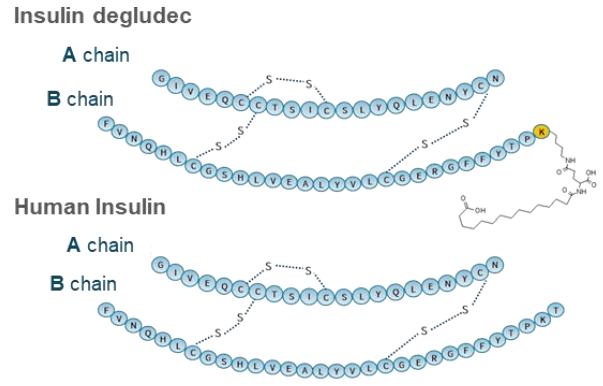 Click to enlarge
Click to enlarge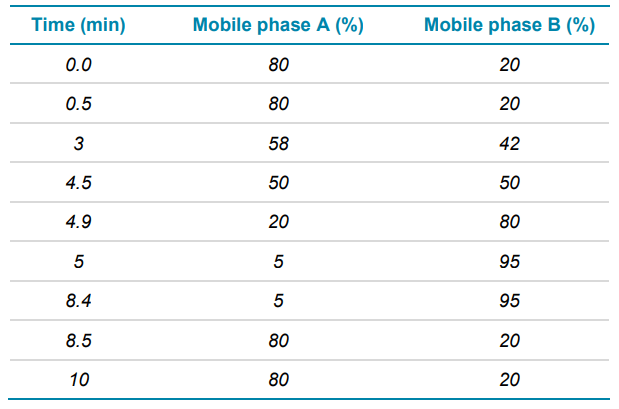 Click to enlarge
Click to enlarge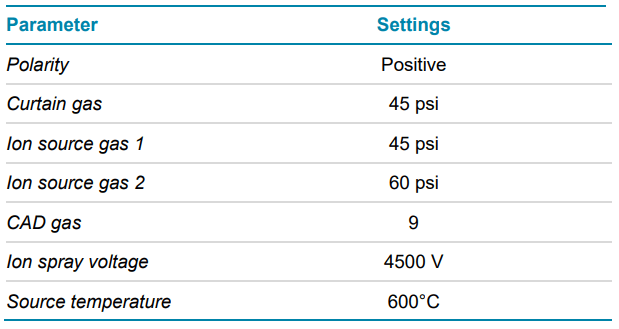 Click to enlarge
Click to enlarge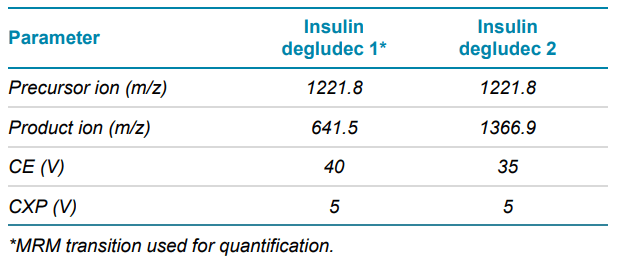 Click to enlarge
Click to enlarge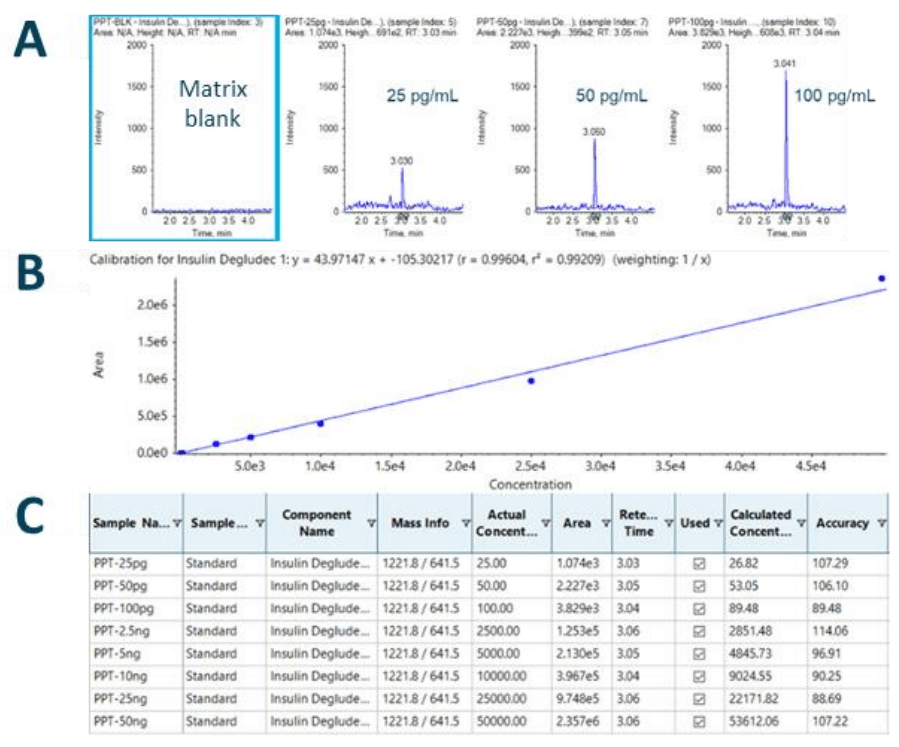 Click to enlarge
Click to enlarge